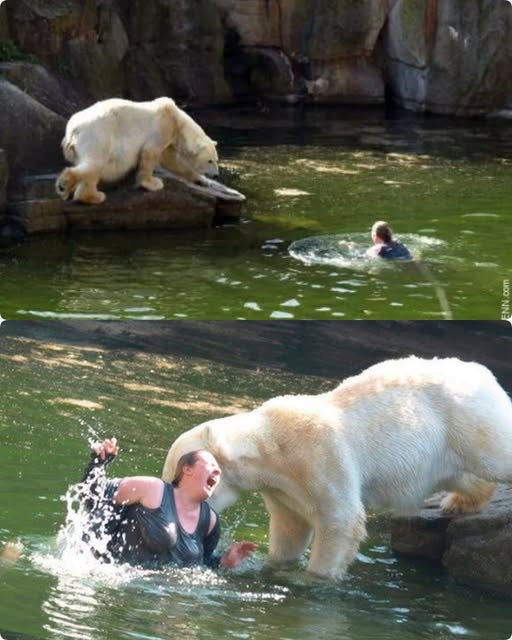Into the Den: The Woman Who Jumped Into a Polar Bear Enclosure.
It was a bright afternoon at the zoo, the kind of day when families flocked to see creatures most would never encounter in the wild. Children pressed their noses against the glass of the aquarium tanks, parents pointed out lions sprawled in the sun, and the distant chatter of parrots echoed in the aviary.
But in the section reserved for Arctic wildlife, where massive polar bears paced behind thick barriers and chilled water glistened under artificial light, something happened that would shake every visitor present.
A 32-year-old woman, visiting alone, made a decision that stunned onlookers. For reasons no one immediately understood, she climbed the safety fence surrounding the polar bear enclosure. Gasps rippled through the crowd as she swung a leg over and dropped into the grassy moat below.
At first, there was silence. Then shouts erupted: “What is she doing?!” Security personnel scrambled, whistles blew, and parents shielded their children’s eyes. But it was too late.
The polar bears had noticed.
One of the massive animals, weighing nearly half a ton, lumbered toward her with startling speed. What had seemed like a lazy, pacing gait moments before became a predator’s stride. The woman barely had time to react before the bear reached her. Its paw swiped with terrifying force, knocking her off balance.
Screams filled the air.
The woman struggled to her feet, but the bear was relentless. Its jaws closed around her arm, dragging her toward the water. She thrashed wildly, crying out in pain, as zookeepers rushed into action. Alarms blared across the facility.
From above, keepers hurled distractions—chunks of meat, loud noises, anything to divert the bear’s attention. Another keeper fired a warning shot from a tranquilizer gun, but the dart bounced off the animal’s thick fur without immediate effect.
Meanwhile, two other polar bears in the enclosure had approached, drawn by the commotion. For a horrifying moment, it seemed the situation would spiral beyond rescue.
And then—miraculously—the woman managed to twist free, pulling herself toward the shallow edge of the pool. Blood trailed behind her, vivid against the pale concrete.
Keepers worked in desperate coordination. A barrier gate inside the enclosure was lowered, separating the most aggressive bear from the others. Trainers shouted commands, their voices firm, commanding, as they tried to corral the animals away.
All the while, the woman crawled toward the inner wall, her movements frantic but weakening. One keeper extended a pole with a loop, hooking it around her waist and dragging her toward the moat’s edge. Two others reached down, risking their own safety, and hauled her out.
The entire ordeal lasted less than five minutes. To those who witnessed it, it felt like an eternity.
Medics rushed her onto a stretcher. Her arm was torn, bleeding heavily, her clothes shredded. She was conscious but in shock, her wide eyes reflecting the horror of what she had just endured. An ambulance whisked her away to the nearest hospital, sirens wailing as families in the zoo stood frozen in stunned silence.
In the aftermath, questions swirled. Why had she jumped? Was it a reckless dare, a moment of mental instability, or some misguided attempt to connect with the animals? Authorities investigated, and reports later suggested that she had ignored multiple warning signs and barriers before making her way into the enclosure.
The zoo defended its safety measures—barriers, warning signs, surveillance—but acknowledged that no system is foolproof against determined human recklessness.
As for the bears, they returned to their routines, their behavior unchanged. For them, the event had been nothing more than instinct—the sudden intrusion of prey-like movement into their territory. They were not punished; to hold them accountable would be unjust. They had acted as wild animals act.
For the woman, survival was both a miracle and a cautionary tale. She would carry the scars for the rest of her life—physical reminders of a decision that nearly cost her everything.
The incident left a deep impression on everyone present. Parents explained to their children, in hushed tones, why barriers exist, why wild animals—even those born in captivity—must be respected from a distance. And staff at the zoo, though proud of their swift response, knew they would relive those minutes in their minds for years.
In the end, the story became less about tragedy and more about survival—a stark reminder of the thin line between curiosity and danger, between human fragility and the raw power of nature.
